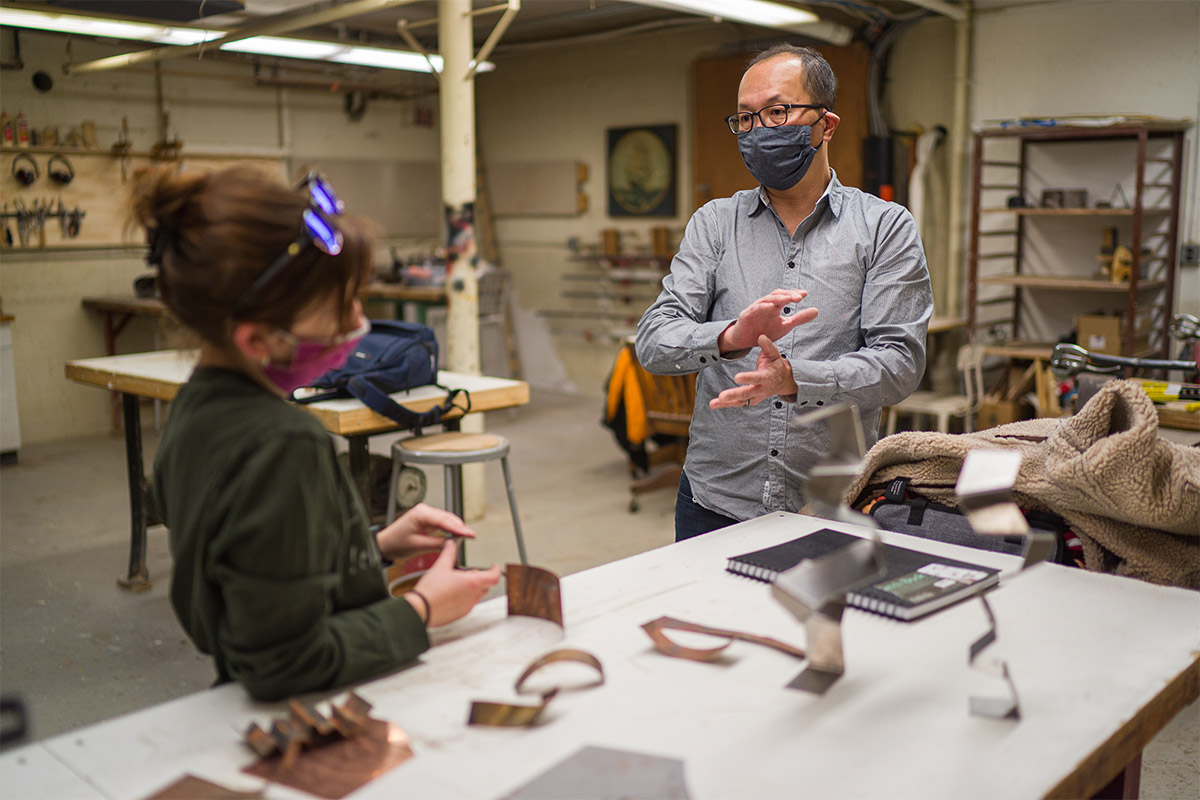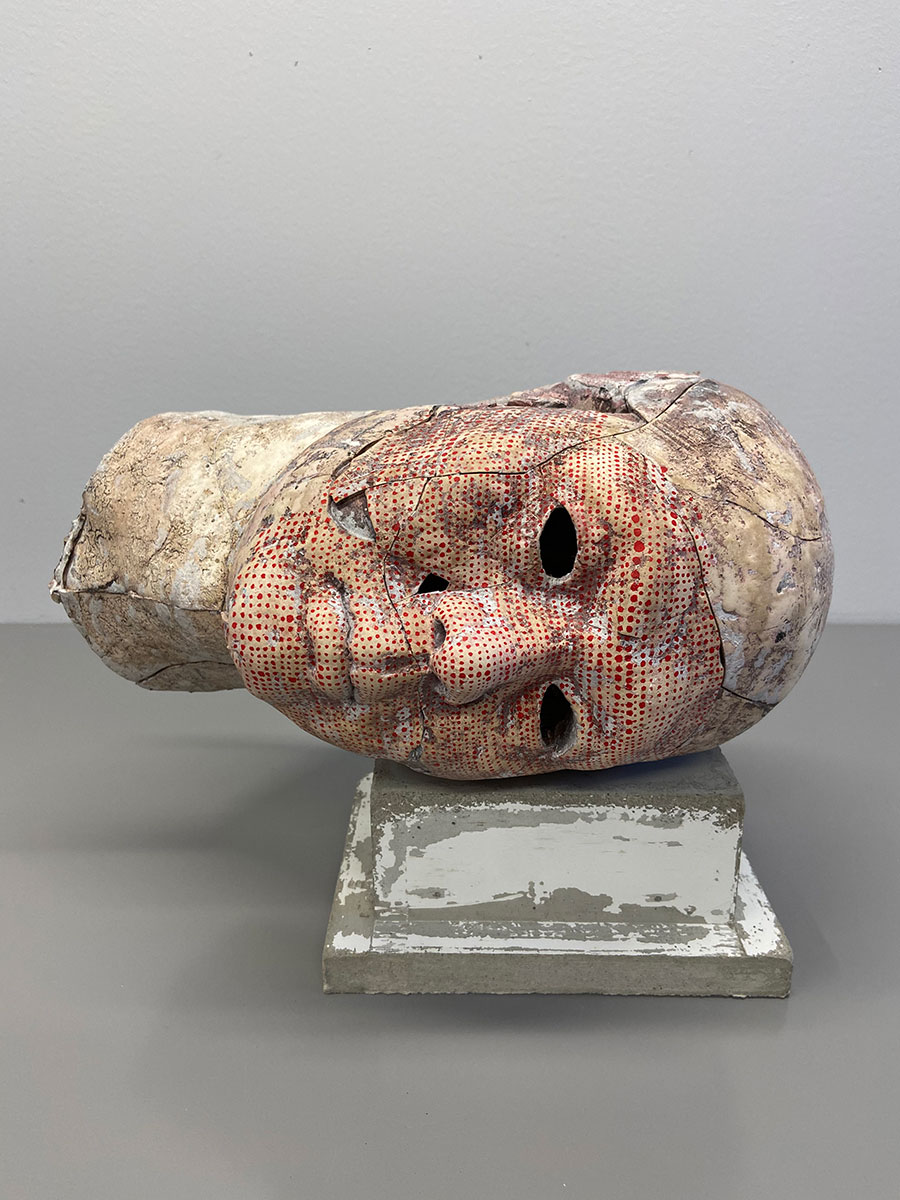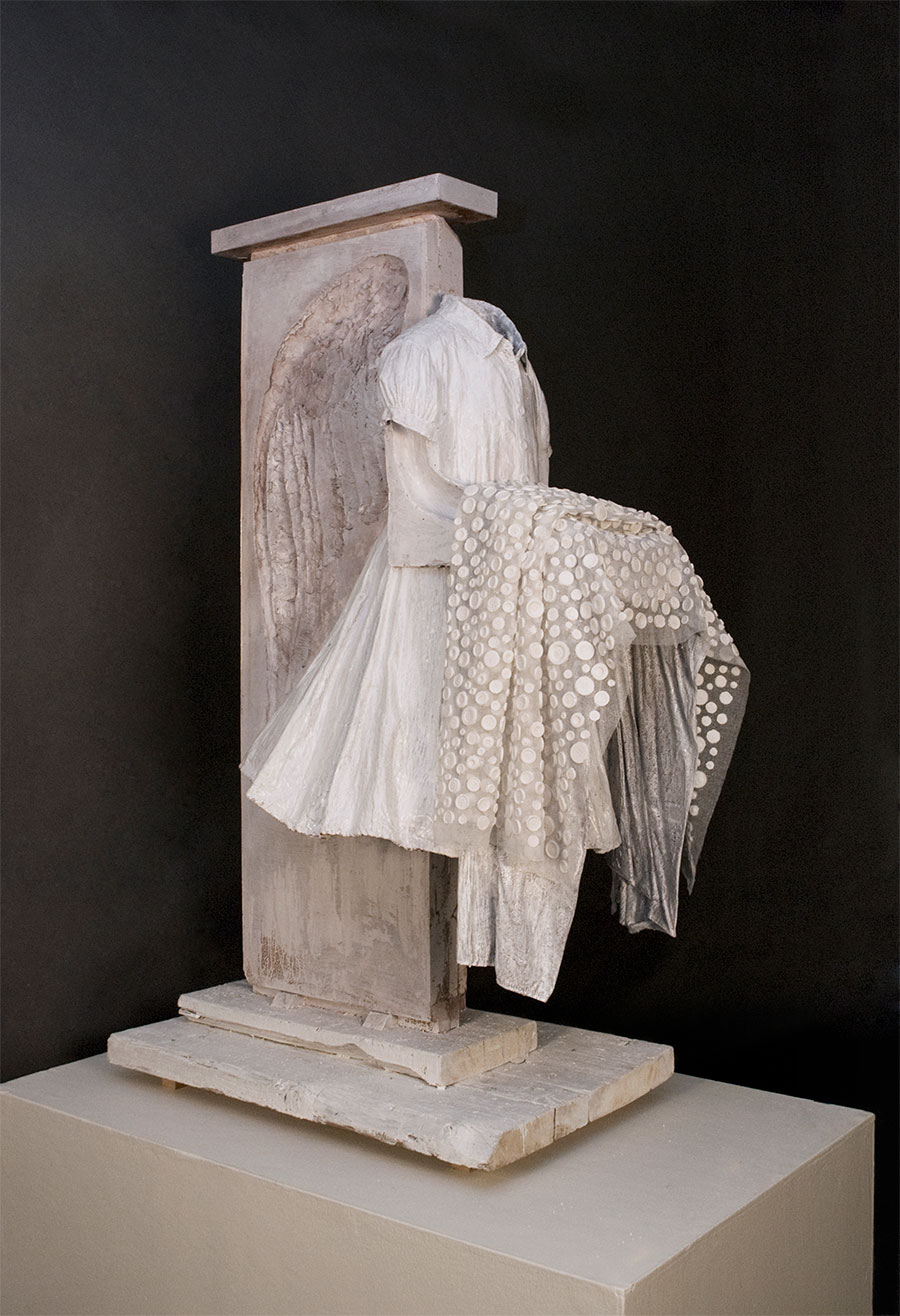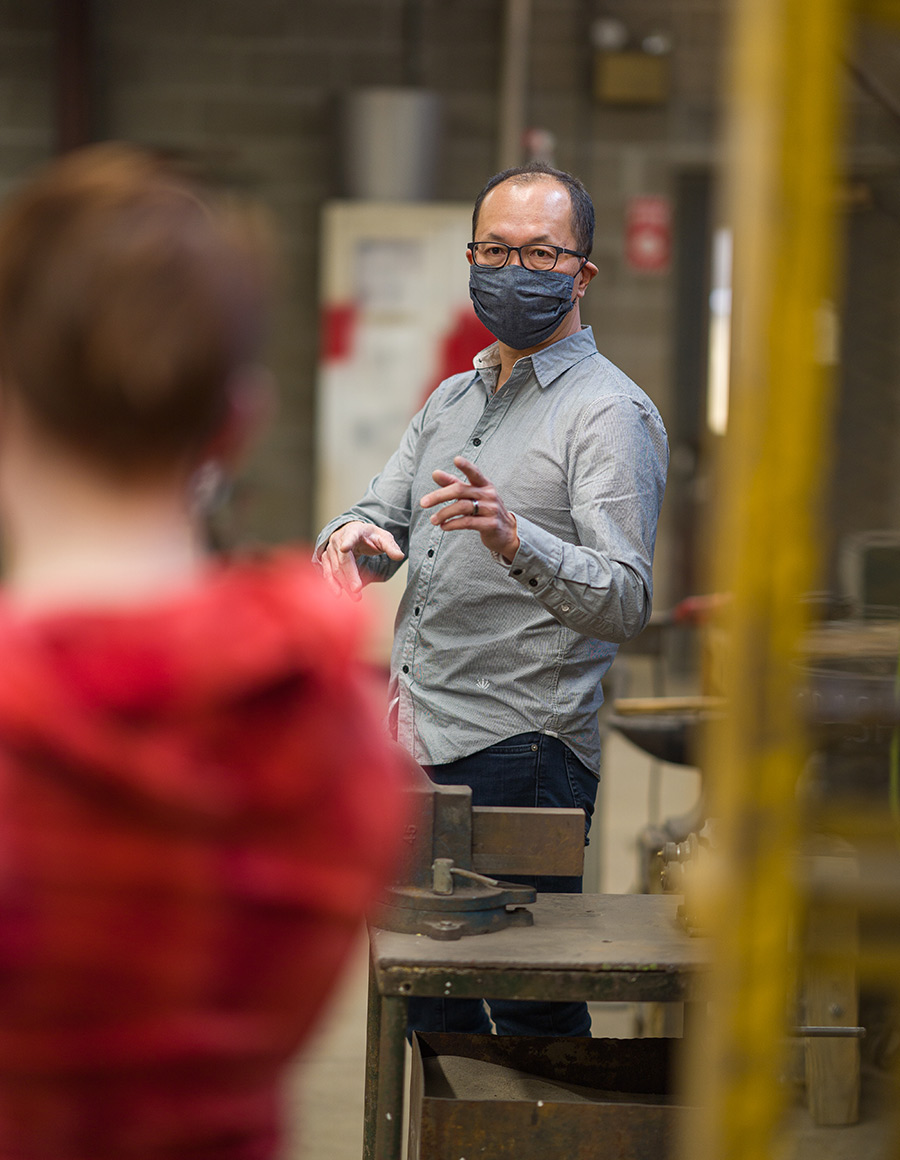en Cariens’ office is lined with a row of sculpted heads. What looks like long tendrils of white string or spaghetti come from their open mouths. The effect is striking, as if the heads emerge from the walls surrounding them. It feels like they have something to say … or scream.
And indeed, the heads have a story to tell. For years, Cariens, an associate professor of art and art history at UNH since 2000, had the rubber mold for one of them laying around. Then, a vessel that was important to him broke — an antique vase from Korea. He glued it back together, and in the process realized there was something really meaningful about putting something back together. He was going through a divorce, reorganizing and grieving, so mending the vessel reminded him of mending himself. Soon after this, he rediscovered the rubber mold. He made a new cast with it, which he subsequently broke and repaired, a process of destruction and revival that evoked the Japanese art of kintsugi, which celebrates the “scars” of mended objects rather than treating them as something to be disguised. It was therapeutic.
“In the course of life, things break, and we have to put them back together,” Cariens says. “We have to put ourselves back together but there’s a real beauty in that process.”
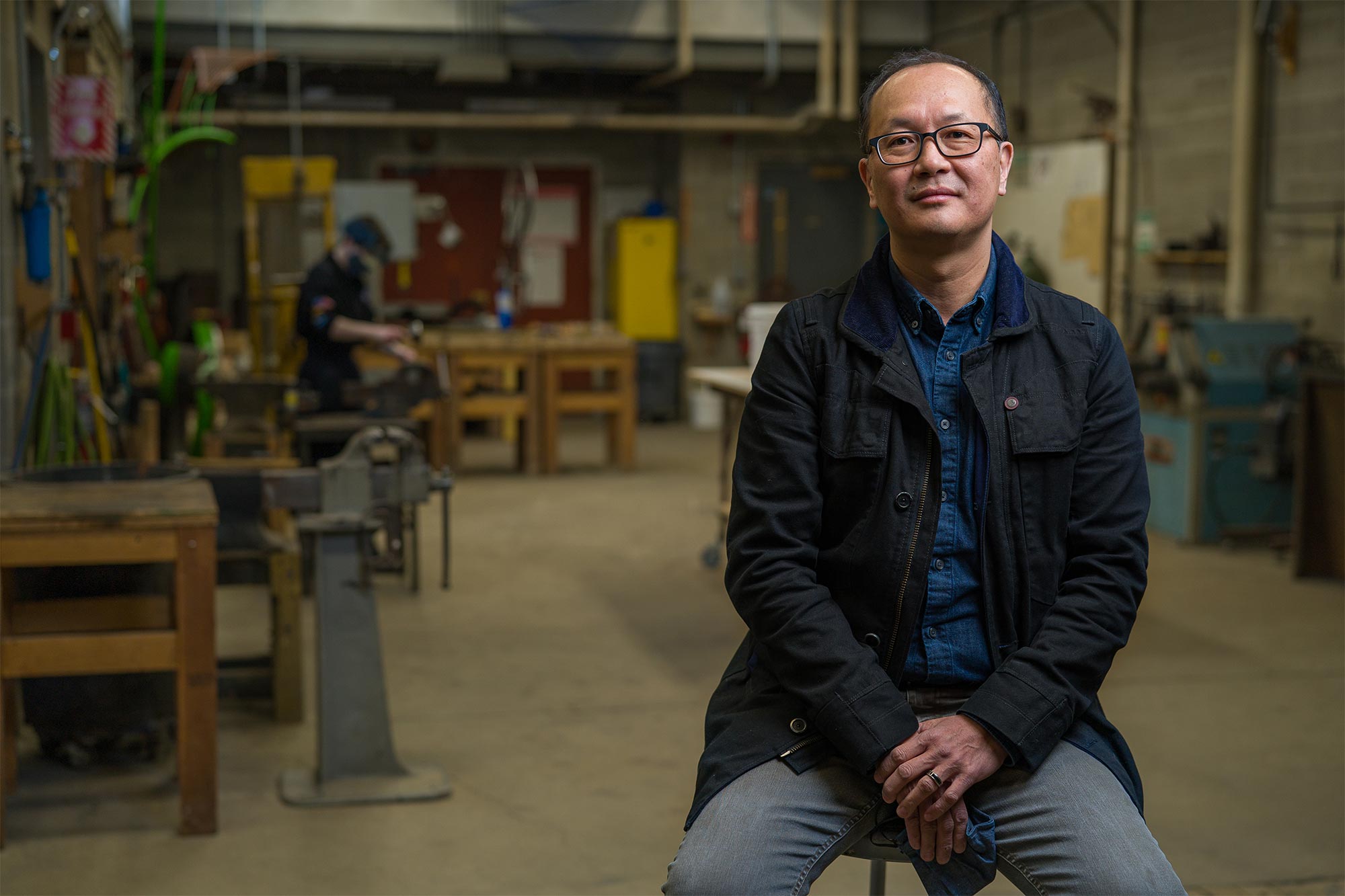
en Cariens’ office is lined with a row of sculpted heads. What looks like long tendrils of white string or spaghetti come from their open mouths. The effect is striking, as if the heads emerge from the walls surrounding them. It feels like they have something to say … or scream.
And indeed, the heads have a story to tell. For years, Cariens, an associate professor of art and art history at UNH since 2000, had the rubber mold for one of them laying around. Then, a vessel that was important to him broke — an antique vase from Korea. He glued it back together, and in the process realized there was something really meaningful about putting something back together. He was going through a divorce, reorganizing and grieving, so mending the vessel reminded him of mending himself. Soon after this, he rediscovered the rubber mold. He made a new cast with it, which he subsequently broke and repaired, a process of destruction and revival that evoked the Japanese art of kintsugi, which celebrates the “scars” of mended objects rather than treating them as something to be disguised. It was therapeutic.
“In the course of life, things break, and we have to put them back together,” Cariens says. “We have to put ourselves back together but there’s a real beauty in that process.”

Because his father worked as an analyst for the Central Intelligence Agency, the family lived near Langley, Virginia, close to CIA headquarters. Cariens joined younger and older brothers who were his parents’ biological offspring. The emphasis in the adoption community at that time was on assimilation and integration, so growing up, his Korean heritage wasn’t an integral part of his family identity.
As a kid, Cariens took great joy and found affirmation in his artistic talent — what he calls “the technical ability to reproduce the world” as you see it. “I think one of the really magical stages of a child’s life is being able to make something that looks like something in the world,” he says. “Although my work has moved in different directions, I’ve never really lost that joy of working from observation and being able to make something that replicates an expression of that observation.”
The emphasis on difference may at least in part explain his discursive path to a career in art. He enrolled at Virginia’s College of William and Mary on a pre-med track but ended up earning a B.A. in art. Directly after completing his undergraduate degree, he moved to Boston to pursue an MFA at Boston University. There, a seminar on the writings of Franz Kafka taught by Nobel laureate and Holocaust survivor Elie Weisel shaped his graduate studies in sculpture — and his interest in Judaism. “That’s a large part of the reason why, after adjuncting and working as a studio assistant to the sculptor Dmitri Hadzi, I enrolled in Harvard Divinity School,” Cariens explains. There, he explored his interests in literature and the history of transmission of narratives in the Hebrew Bible.
While at Harvard, Cariens wasn’t sure he would ever return to the art studio. But he started to feel dry, like reading and writing weren’t his only passion. He missed making stuff and getting dirty. “Eventually my studies in the symbols, rituals and concepts of the Hebrew Bible, as well as studies in the Talmud and Biblical Hebrew, became central to my studio work,” Cariens says. The first time someone at UNH called him to ask if he wanted an adjunct teaching position in the art department, he turned them down; he was living in the Boston area and didn’t have a car. When UNH called him a year later and offered him a full-time position as an art instructor, he accepted.

In the process of making art, Cariens is unconscious of the work’s meaning. “A lot of times I didn’t know what it meant or reflected until after the fact. I think in the works that I’ve done that feel most successful to me, I’m still figuring out what they mean. They reveal things about myself that I hadn’t recognized.”
He comes back to the theme of structure and home often, which he attributes to his early years as a “homeless orphan.” “The idea of place and home — especially as I get older with my kids — become more prominent,” he says. Although Cariens clearly loves making things, his family comes first. He has two sons, 13 and 15, from a first marriage and a daughter, 2, that he’s raising with his current wife.

Cariens’ classes meet twice a week; three-hour blocks of time in which phones and other technological distractions are forbidden.
Today begins with a warm-up. “These are the best lines you’ll make all day,” Cariens says as he instructs students in his Intro to Drawing class to run their pencils down the paper without looking at it. This approach encourages them to see clearly, paying closer attention to the arrangement than to critiquing the accuracy of marks on their page. Cariens’ teaching philosophy is about allowing a full range of creative motion, both supporting and challenging his students toward their best work.
Students respond well to this kind of coaching. “Ben can work with anyone and see what they need to do to improve their work,” says one.
As for his own work, “Every artist needs to figure out what they need,” Cariens says. “What do you need not just to feed your art, but to feed you as a person?” As a student, many of his instructors told him he needed to be sketching every day, getting to the studio every day. “And they’re right if you want to produce a lot more work,” he says. “The problem is I’ve never worked well that way. I’ve worked in response to necessity. Like I’ve just been haunted by this group of images and I just have to put them out there.”
Cariens believes in patience and letting ideas marinate. If an idea is urgent enough, it will make itself heard. “I like [the idea] sitting in my brain for a while. And part of me is like the ones that stay with me longer have a kind of urgency. There’s a reason why stuff sticks with me and that’s my first initial filter. A whole generation of artists say you should have no filter and everything should be out on the page and I’m just not like that.”
To that end, he’s comfortable with making nothing at all — and has a stash of unused sketchbooks to prove it. He calls creative fallow periods “ingatherings” and notes that they don’t need to be a negative experience. It’s all about what an artist does with the time when they’re not creating.
“It’s a reading period, a time for watching movies, going to gallery shows, going to poetry readings, going to talks. I need to value that. I need to protect that. Because that’s going to be the first part of my life that people start to sideline because it’s considered supplemental, not focused. But I think for an artist that’s the most important stuff,” Cariens says.
He cautions students and young artists about the guilt they may feel if they’re not constantly producing new work. These days, with apps like Instagram and TikTok, the pressure to be making quality work and sharing it on a regular basis is high. Cariens reminds artists to make art when they want to make it, not when they feel like they have to. He also warns students about profiting from their art and says there’s something that gets lost once your art becomes your business. “If it starts to become a product that you market and you’re living off of, it’s complicated to try and maintain a sense of protecting the impulse of what made you want to engage in that way in the world,” he says.
Cariens is most proud of his shows at the Boston Sculptors Gallery. There, he’s encountered viewers who have been so moved by his work that they’ve come up to him in tears. Indeed, the strongest reactions tend to be in response to the work from one of the darkest periods of Carien’s life: his divorce. The piece has stirred something in them that they recognize and for Cariens it’s rewarding to see how his art has moved someone. These days, Cariens does fewer shows. He’s more focused on his family and his teaching.

“There is something magical, mystical, spiritual, religious about the creative process,” he says.
When the students return from their break, many hold coffees from the nearby food truck. They slip their phones back into pockets and backpacks and Cariens asks them to all move one seat to their left. He instructs them to edit their classmates’ drawing, making it more true to the forms in front of them. This is a way of freeing up their attachment to their work and seeing the arrangement from different perspectives. They take to editing others’ drawings with great care.
Students in Cariens’ Intro to Drawing class credit his guidance with artistic growth well beyond the classroom. “Our assignments were challenging, but I was ready for it and made huge leaps in my drawing skills, which spread out through painting, water media and even 3D works from then on,” one says. “I loved the written evaluations of each assignment — detailed, thoughtful and helpful.”
The class concludes with Cariens’ homework announcement, which spurs a flurry of packing up. Students heave torso-sized drawing pads into carrying cases and gather up pencils, sharpeners and erasers. After speaking with a few students who have questions, Cariens stands alone in his classroom, awaiting the arrival of 24 more young artists. The open windows let in the cool fall breeze and he moves the blue vase at the center of the arrangement an inch to the right.
